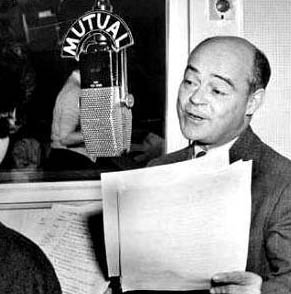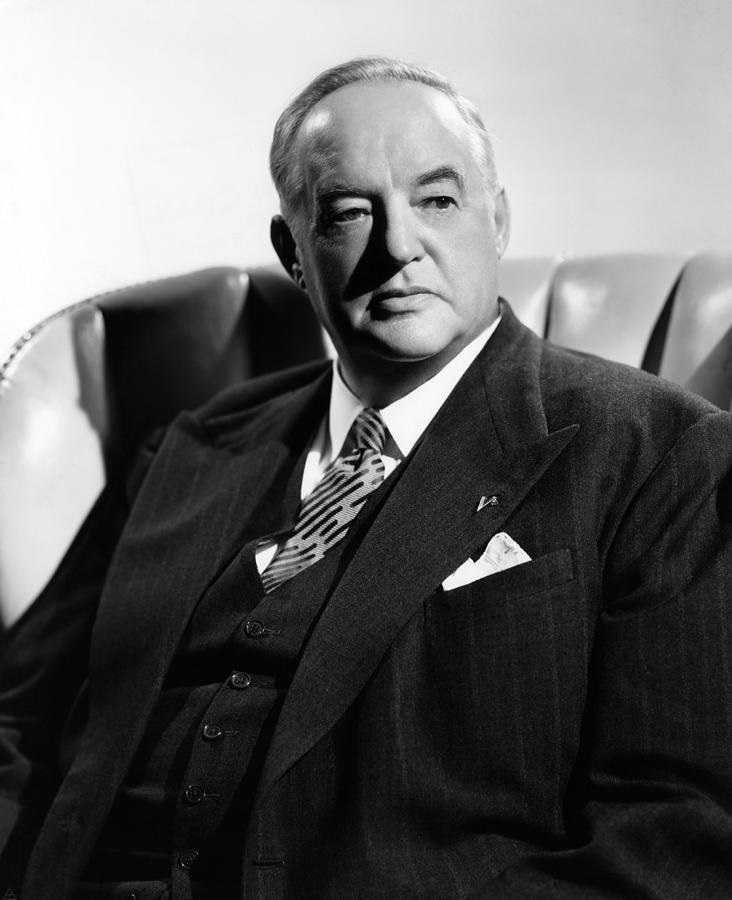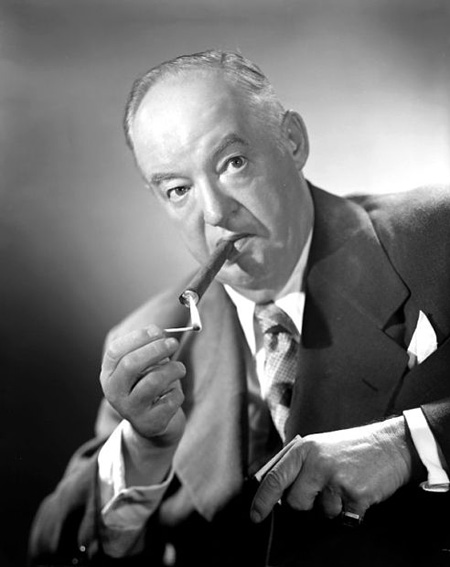“…the bulkiest, balkiest, smartest, most unpredictable detective in the world…”
Posted by Ivan G. Shreve, Jr. on Apr 7th 2015
On this date in 1943, the first of several attempts to introduce radio to one of the most memorable of literary sleuths got underway. Nero Wolfe, the well-upholstered creation of author Rex Stout, was introduced in 1934 in the pages of Fer-De-Lance. The first of 33 novels (and 39 short stories) introduced the eccentric bon vivant with a taste for cold beer, fine food and orchids. (I should stress this last item wasn’t on the menu). Nero lived lavishly in an elegant New York City brownstone—but because of his fondness for the finer things in life, he had turned to detection to pay the bills.
The only trouble was—Wolfe loathed venturing outside his familiar environs (he had an aversion to both travel and trains), and so he often depended on his “leg man,” Archie Goodwin, to do the heavy lifting. (I’m not kidding about the “heavy” part; Goodwin once guesstimated his boss’ girth at about 286 pounds). Goodwin was more in keeping with the traditional private eye cliché – a hard-boiled wisecracker with an eye for a shapely dame – yet his most important function was to serve as the narrator for their various misadventures.
The success of Fer-de-Lance eventually led to Stout’s being besieged with offers from movie studios to adapt Wolfe to the silver screen. Rex himself thought Charles Laughton would make an outstanding Nero (and it’s certainly fun to speculate), but Columbia Pictures (who purchased the screen rights to the novel for $7,500) refashioned the book into Meet Nero Wolfe for contractee Edward Arnold—reasoning that they could keep the actor busy in between more prestigious assignments with a series of “B” programmers budgeted to play on the bottom of movie theater double bills. Meet Nero Wolfe (1936) was actually a borderline “A,” and featured a young Margarita Carmen Cansino on her way to becoming Rita Hayworth. It was directed by Herbert Biberman who, along with Arnold, was not asked back for the second (and last) film in the series, The League of Frightened Men (1937; Stout’s second Nero book). Walter Connolly took over as the corpulent Wolfe in that feature, with Lionel Stander reprising his role from the first film as Archie Goodwin.

Stout was adamant about authorizing any more movies featuring his creation. (You can’t really blame him; the studio had Nero switching from beer to hot chocolate in Frightened Men.) But he was amenable to a radio adaptation, The Adventures of Nero Wolfe, which premiered over a small regional network (The New England Network) on April 7, 1943, and featured J.B. Williams as Wolfe. That series ran until June, and in July it moved to the Blue network with veteran Santos Ortega as the show’s star. Ortega would later be replaced by Luis van Rooten (in January of 1944) until the show left the airwaves on July 14, 1944. (John Gibson, best remembered as “Ethelbert” on Casey, Crime Photographer, played Archie during the Blue network run.) A disagreement between producer Himan Brown and Edwin Fadiman—the man who oversaw Stout’s radio, movie and television interests as Nero Wolfe Attractions, Inc.—is what kept The Adventures of Nero Wolfe from returning to the now-retitled ABC network.
Nero Wolfe, however, would not be silenced where the airwaves were concerned. Mutual resurrected “the detective genius who rates the knife and fork the greatest tools ever invented by man” in the summer of 1946 on a Sunday night series sponsored by Jergens Lotion. The series was retitled The Amazing Nero Wolfe and appearing as “the gargantuan gourmet” was former silent movie legend Francis X. Bushman…with Elliott Lewis as Archie. Produced and directed by Travis Wells and scripted by Louis Vittes, the new Wolfe series was criticized by Stout biographer John McAleer for its “slapstick” humor. The Amazing Nero Wolfe went off the air on December 15 of that same year.
 When NBC premiered The
New Adventures of Nero Wolfe on October 20, 1950, fans
of the detective had to be wondering if the third time would be the charm. The
actor chosen to play the rotund gumshoe seemed to be a natural; Sydney
Greenstreet, who hit one out of the park with his first movie role in
1941’s The Maltese
Falcon (at the age of 62, after a lengthy stage
career)—his character of Kasper Gutman in Falcon was even referenced as “the fat
man.” Greenstreet had solid radio credentials: he appeared on such programs
as The Lady Esther
Screen Guild Theatre and Academy Award Theatre,
and poked fun at his silver screen persona alongside comedians like Fred Allen
and Bob Hope. But the actor’s participation on New Adventures didn’t
come cheap, and even with the input of Vittes and Fadiman, NBC had difficulty
locating a sponsor (Plymouth signed up briefly, then lost interest) so the
series was mostly sustained during its one-year run.
When NBC premiered The
New Adventures of Nero Wolfe on October 20, 1950, fans
of the detective had to be wondering if the third time would be the charm. The
actor chosen to play the rotund gumshoe seemed to be a natural; Sydney
Greenstreet, who hit one out of the park with his first movie role in
1941’s The Maltese
Falcon (at the age of 62, after a lengthy stage
career)—his character of Kasper Gutman in Falcon was even referenced as “the fat
man.” Greenstreet had solid radio credentials: he appeared on such programs
as The Lady Esther
Screen Guild Theatre and Academy Award Theatre,
and poked fun at his silver screen persona alongside comedians like Fred Allen
and Bob Hope. But the actor’s participation on New Adventures didn’t
come cheap, and even with the input of Vittes and Fadiman, NBC had difficulty
locating a sponsor (Plymouth signed up briefly, then lost interest) so the
series was mostly sustained during its one-year run.
The low ratings for Nero Wolfe explain why five actors—Wally Maher, Lawrence Dobkin, Herb Ellis, Gerald Mohr and Harry Bartell—all played Archie Goodwin during the program’s single season on the air. Old-time radio historian Stewart Wright reminisced that after seeing Dobkin, Ellis and Bartell recreate a broadcast of the series at a radio convention in 1999 he learned “[t]he reason why there were so many Archies during the Greenstreet run is that the ratings for the series were never good and Greenstreet, as the star, could not believe that the poor ratings were his fault, so the fault must lie with the actor playing Archie. Therefore, [the] actor playing Archie was changed several times. Obviously, the changes didn’t help.”
The fate of The New Adventures of Nero Wolfe was a sad one, because Stout was quite positive about Greenstreet’s participation (Rex just thought the scripts were lousy). And who knows? Had the attempt been made to keep the Wolfe franchise stable in the early years of its broadcast history, it might have enjoyed a more successful run during Radio’s Golden Age. The New Adventures of Nero Wolfe made its last bow at the curtain on April 27, 1951. Except for a brief attempt at resuscitation in the early months of 1982 courtesy of the Canadian Broadcasting Corporation, Nero Wolfe soldiered on in his brownstone, saddened that the aural medium hadn’t been kinder to his legacy.

Still, time was pretty good to The New Adventures of Nero Wolfe; of the twenty-six shows originally broadcast, only one didn’t survive the ravages of neglect (“The Case of the Headless Hunter,” from November 11, 1950). The surviving shows are featured on two Radio Spirits collections: The Case of the Midnight Ride and Other Tales and Parties of Death. To compensate for the missing “Hunter,” Parties includes an April 16, 1945 broadcast of The Lady Esther Screen Guild Theatre: “The Mask of Dimitrios,” a radio adaptation of the 1944 suspense thriller with Greenstreet and Peter Lorre recreating their original roles. (Trust me—you don’t want to miss it!)

